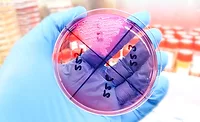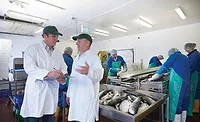Global Standards Impacting Food and Beverage Processors

Globalization has helped to create a business environment where geographical boundaries are blurred. Businesses and people are more interconnected through advanced technology and means of communication, where the exchange of an international good or service can occur with just the click of a button.
Aside from country-specific trade agreements, opportunities for international commerce have become nearly seamless. But with international commerce comes accompanying regulations, especially for food and beverage manufacturers. In fact, the food and beverage industry continues to be one of the most regulated industries to ensure consumer health and safety.
To remain compliant and protect brand integrity, food and beverage processors must be familiar with key global regulatory bodies and their safety standards for food contact materials, which can vary from country to country.
Global Standards, Common Goal
Despite the varying food and beverage standards around the globe, most regulatory bodies have one common goal: to protect the health and safety of consumers. This includes, but is not limited to, regulations for tubing that comes into direct or indirect contact with food and beverage materials. Tubing transfers and dispenses beverages and other foods with liquid-like consistencies across beverage processing operations—including soft drinks, bottled water and fruit drinks, along with alcohol (beer, wine and liquor) and dairy products like ice cream and milk.
Foods or beverages passing through tubing that has been contaminated with a buildup of bacteria, for example, can have foul effects on the product’s end taste or smell, also known as organoleptic properties. Bacteria buildup can also negatively affect overall hygiene and cleanliness. In more severe cases, chemicals leaching from the tubing composition into a food and/or beverage can have a negative impact on the product’s organoleptic properties, but an even more damaging impact on processors’ ability to achieve compliance with regulatory standards that govern the health and safety of foods and beverages for consumer consumption.
European Union
The European Union (EU) has enacted the Regulation on Registration, Evaluation, Authorization and Restriction of Chemicals (REACH) to protect human health and the environment from risks associated with a variety of hazardous chemicals. Beyond REACH, the EU also outlines specific rules to regulate articles or materials that come into contact with food.
For example, the Framework Regulation—or Food Contact Materials Regulation—covers the safety of all materials that might come into contact with food. Also known as Regulation (EC) 1935/2004, it states that any material intended to come into direct contact with food must be sufficiently inert to prevent substances from being transferred to the food in quantities large enough to endanger human health, bring about unacceptable changes to the food’s composition or deteriorate its organoleptic properties.
Looking for quick answers on food safety topics?
Try Ask FSM, our new smart AI search tool.
Ask FSM →
In addition, Regulation (EC) 2023/2006 lays out Good Manufacturing Practices (GMPs) for the development of food contact materials, which apply to all sectors and stages of manufacturing, processing and distribution. In Europe, all food contact materials are required to meet both Framework Regulation (EC) 1935/2004 and Regulation (EC) 2023/2006. There are additional safety regulations that have been put into place by the EU, which are applicable to all plastic materials and articles intended to come into contact with food. For example, Plastics Regulation (EU) 10/2011—also known as Plastics Implementing Measure—includes directives for food contact involving plastics. These materials can include packaging, food storage containers, kitchenware or utensils, as well as the plastics found in tubing materials that are often employed in food and beverage processing applications.
Plastics Regulation (EU) 10/2011 authorizes modeling as well as experiments to demonstrate product compliance. In fact, Saint-Gobain has recently helped develop a model in collaboration with academia to evaluate compliance using some of its Tygon® tubing products. The dynamic conditions of the particular model were selected based on an intimate knowledge of the food applications and situations that Saint-Gobain’s Tygon products typically endure and were continuously monitored for safety compliance.
North America (U.S. and Canada)
In the United States, the U.S. Food and Drug Administration (FDA) is the main governing body that oversees food additive standards.
The Federal Food, Drug and Cosmetic Act prohibits the adulteration of food, which is aimed to ensure the U.S. food supply is safe by preventing contamination. This includes food contact substances (FCS), or any substance that is intended for use as a component of materials for manufacturing, processing, packing, packaging, transporting or holding food—as well as tubing that is typically used in food and beverage processing systems.
To date, the FDA has established a food contact notification process as the primary method of regulation when the FCS is not subjected to any food additive regulation, such as the Code of Federal Regulations, Vol. 21, Parts 174 to 186, Threshold of Regulation, Food Contact Notification Clearances and more.
Other U.S.-based standards include 3-A Sanitary Standards, which are managed by an independent organization that is dedicated to advancing hygienic equipment design for the food and beverage industry. Much like the government regulations for the food and beverage sector, 3-A Standards also share a common commitment to promoting food safety and public health.
The widely recognized 3-A symbol—which is also known as the Symbol of Assurance—indicates that food and beverage equipment meets 3-A’s design and fabrication standards. It is considered to be among the best in the food and beverage category, particularly within the dairy industry.
Lastly, the National Sanitation Foundation lists appropriate materials and manufacturing processes for the production of food safety materials, ensuring that products coming into contact with food and beverages meet specific safety standards.
In Canada, the main regulation affecting international food and beverage processors is the Safe Food for Canadians Act, which is enforced by the Canadian Food Inspection Agency (CFIA).
The standards require all food manufacturers, including processed food manufacturers, to be licensed and have preventive control systems, such as Hazard Analysis and Critical Control Points (HACCP) plans or their equivalent. HACCP plans help find, correct and prevent hazards throughout the production process to ensure food safety and integrity.
Further, the Canadian Food and Drugs Act outlines specific standards and regulations for various types of foods and beverages. For food contact materials in particular, both Division 16 on Food Additives and Division 23 for Food Packaging apply.
Japan and China
In Japan, the Ministry of Health, Safety and Welfare has enacted the Food Sanitation Act. This act defines additives as “substances which are used by being added, mixed or infiltrated into food or by other methods in the process of producing food.” Only additives on the approved “positive list”—which designates select materials as safe for food and beverage processing applications—may be used.
The fundamental law regulating “food-related products” in China is the Food Safety Law and China’s National GB (Guobiao) Standards, which are monitored by the China Food and Drug Administration. Much like their international counterparts, the Food Safety Law and China’s GB Standards seek to ensure food safety and consumer health.
The Chinese Food Safety Law includes generally applicable standards, material standards, testing methods standards and GMP standards. The newest draft that applies to additives in food contact materials (GB 9685) was released in January 2015. More specifically, the updated Food Safety Law includes regulations for food manufacturing that will be more closely enforced, as China continues to refine the provisions and associated regulations. Food and beverage manufacturers should continue to stay aware of the significant changes that have been made.
Achieving Regulatory Compliance
Individual food and beverage processors are responsible for achieving compliance with various global regulations before placing a product into the marketplace. Material specification for tubing is a good place to start when looking for ways to assure regulatory compliance. Certain tubing materials are especially prone to leaching flavors or susceptible to imparting tastes from other substances into the product. From a safety and regulatory compliance standpoint, tubing materials should not leach chemicals into the food or beverage products.
The most effective course of action that beverage processors should take to ensure product quality is to partner with a knowledgeable component supplier that can provide guidance on proper tubing solutions. For example, Saint-Gobain Process Systems offers a complete portfolio of Tygon S3™ tubing solutions that complies with the industry’s most recognized regulatory standards around the world, including those set by REACH, FDA, 3-A, CFIA, Japan’s Ministry of Health, Labor and Welfare, China’s Food and Drug Administration and more.
Further, food and beverage processors must anticipate inevitable regulatory changes related to bisphenol A and phthalates, which are being driven by perceived consumer safety concerns. They can stay ahead of the curve by requiring phthalate-free tubing solutions like Saint-Gobain’s Tygon S3 B-44-3, which is a phthalate-free, bio-based tubing that combines the high-performance standards that customers demand with an eco-friendly tubing design. It is specially formulated for transferring a wide variety of beverages, including soft drinks, fruit juices, flavored teas and bottled water.
Choosing the right tubing solutions supplier with comprehensive design capabilities and products can also help food and beverage processors to design and/or select high-performance, long-lasting dispensing equipment.
Iuliana Nita is the global marketing manager, Food and Beverage, Process Systems Business Unit at Saint-Gobain Performance Plastics.
Resource
1. Pigeonneau, F, et al. 2016. “Numerical Investigation of Generalized Graetz Problem in Circular Tube with a Mass Transfer Coupling between the Solid and the Liquid.” Int J Heat Mass Transf 96:381–395.








